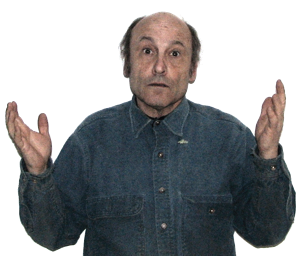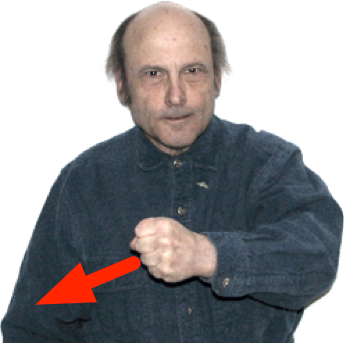April 3rd, 2010
It recently occurred to me that explaining some my public speaking techniques might be of some value to others. While many of my own techniques are, shall we say, uniquely suited to Chris Crawford, there are also some tricks I use that anybody else can use. Here they are:
Be Yourself
This is the first and most important rule. Don’t try to fit into some role. Don’t try to act like you think an eloquent speaker should act. Dont’ act, because you’ll always be sweating the possibility that you might slip up and let the real you slip out. Just be yourself. You’re an interesting person and you have interesting things to say, so just get down and say them the same way you would say them if you were conversing with an individual. Except you want to add some punch to your words.
Fear
You’re scared. What if you screw up and say something stupid? What if you forget what you were going to say and freeze? What if a heckler says something nasty?
Accept your fear. I have given literally thousands of lectures -- I do not exaggerate -- and I still get scared every single time I get up in front of an audience. Things can and do go wrong. I have forgotten what I was going to say. I have been interrupted by rude questions. I have said stupid things.
Once, while lecturing in Tokyo before a huge audience of at least a thousand people, I did a little hop to illustrate a point -- and failed to take into account the assiduousness with which the Japanese wax their stage floors. My feet came right out from underneath and I fell hard on my butt right in front of all those people. The whole audience gasped. I sat there on the floor feeling like a total fool, and I couldn’t help myself: I broke into a huge grin as I looked at the audience. The entire audience erupted in tumultuous laughter. All my earlier attempts at humor had failed with this serious audience, but falling on your butt is funny in every culture. What saved me was that I wasn’t trying to act like Mr. Chris Crawford, the World’s Greatest Authority. I was just plain old me up there, and I had to laugh at myself when I fell on my butt.
Just be yourself. If you fall on your butt, laugh at yourself, and the audience will laugh, too. If you say something stupid, pause and then say, "Gosh, that was really a stupid thing to say. What I should have said was..." If you forget your speech, say, "Looks like I forgot what I was going to say next. Let me look at my notes..." At this point, I often rush through key words of the speech as I scan the notes: "Interactivity... essence of computing... stupid joke... three rules... ah yes, here we are!" Just don’t sweat it. The fear is more destructive than the mistake ever could be. The best way to deal with mistakes is not to prevent them but to recover from them, and the easiest way to do that is to avoid putting up a pretense. Aw, shucks, if it’s just dumb ol’ me up there shootin’ his mouth off, ain’t no big deal if’n I say sumpin stupid, right?
Voice
Your first concern is your vocal performance, and the first rule here is to lose that deadly monotone. You need to put some life into your vocal performance, some intonation. The key to doing so lies in the way your frame your material. You have to care about what you say. If you don’t really care about the material, then you will communicate that apathy to your audience. You should be consumed with the thought that "THIS IS IMPORTANT!" If you approach your material that way, and maintain that feeling throughout your presentation, then your vocal intonations will be appropriate. Whatever you do, don’t try to force it; you’ll sound artificial. Remember, acting might entertain your audience, but it won’t fool them.
Imagery
PowerPoint. Everybody uses it and everybody has seen it used so many times that they hate it. Yes, PowerPoint can be deadly dull. I refused to use such things for many years because they direct the audience’s attention to a dead screen rather than a live speaker. The human element gives life to a speech; if the lights are down and they are staring at a dry list of bullet points and hearing a disembodied voice, they won’t pay much attention. I keep the lights up and focus their attention on myself, because I’m the only one who can make the material come alive.
But then I saw this 17-minute video of Scott McCloud speaking at the TED conference, and it changed my thinking. Now, I think that Scott blew it by putting entertainment ahead of content, but that doesn’t matter: the important point is that Scott used images, not text, in his PowerPoint presentation. That’s the magic solution: use PowerPoint for images, and the voice for language. Never put text onto the screen. I’ve had to bend this rule a few times, but just to provide labels for elements of an image that isn’t obvious. You want lots and lots of images, at least one image per minute of speaking time, and preferably much more. The end result is truly impressive. I can’t represent it here, because, after all, this is a different medium and what works well in one medium seldom translates well into another medium. But someday you should see one of my new-style lectures.
Gestures
Do you know how to silence an Italian? Bind his hands. That hoary old joke expresses an important idea: that gestures play an important role in vocal communication. That’s one reason why some linguists believe that language evolved in conjunction with gestural expression, the very first manifestation of which was the use of pointing conjoined with a word meaning "That thing I’m pointing at". Although English-speakers seem reticent with gestures, they still recognize a wide variety of gestures. Here are some of the gestures I use that work well with most audiences:
Both arms moving as if to draw a wide circle with the hands: entirety, everything, the whole shebang.
One hand stabbing forward horizontally, with index finger extended: emphasis, importance. Raise your voice when you use this gesture.
One arm raised, index finger pointing upward: "Here’s in idea" "take note"
Hands crossed at waist height, palms down, moving horizontally outward: negation, nobody, nohow, never
Index finger of one hand placed on the side of the head, head tilted slightly toward finger: thought process "one might think that..." "I once thought that..." "If you think about it..."
Fingers of one hand rubbing forehead as if you have a headache: difficulty, a problem to consider
Fingers stroking the chin, coupled with lowered eyebrows: consideration of complex factors or a difficult problem
Both hands extended outward at the sides, slightly raised, with palms up: a question or "why?"
Index finger pointing horizontally forward then sweeping outward: "absolutely!"
Fist moving diagonally forward, stopping suddenly: power, decisiveness
Body Language
Here’s a simple rule:
Don’t ever hide behind the lectern!
Doing so puts emotional distance between you and your audience. You want to free your body and get it out in the open where people can see all of you. Then you need to move around. The purpose here is to communicate energy and enthusiasm. If you’re lazily standing behind a lectern, you communicate laziness and inaction to your audience. You’ve got to get out in front of them and move around like a caged animal. The nature of your motions and positions can communicate a great deal to your audience. The most obvious example is the use of counterpositions for discussions of the type "On the one hand... on the other hand". Another method is to develop a logical argument by starting at the right side of the stage (as you face the audience) and taking a step leftward with each new step in the argument, reaching your conclusion as you reach the left side of the stage. I have used this to great effect (for example, in the Dragon Speech), by physically going back to a crucial step in the argument and saying "Right here, I said that..."
Body language and physical position can be used to communicate lots of other things. For example, while discussing the finer points of an issue, I’ll sometime clasp my hands behind my back and slowly stroll around, suggesting the discursive nature of the concept. Another good device is to suddenly stop dead center on the stage, forward, to make an important point, then resume moving when you proceed to explanatory, development, or expansion material.
"But how shall I be able to consult my notes as I speak?" I hear you moan. Yes, that’s a problem; your notes are a really useful crutch, and speaking without notes is like walking a tightrope without a net. Here’s where rehearsal comes in. If you rehearse your speech enough times, you should be able to memorize the entire thing. Don’t try to memorize it word for word -- memorize the sequence of points you want to make. The clever phrasings will stick in your mind and you only need to extemporize the glue phrasings. But if worst comes to worst, and you forget your next point, don’t sweat it. Just use the technique I described above. The audience will not think less of you; they know how difficult it is to memorize a long speech. And don’t print out the whole damn speech; at the last rehearsal, write down the major trigger phrases that you find yourself tripping over. Most of a speech is easy to remember, but there are always killer transition points that elude memorization. Write down the key phrase for each of those transition points and you’ll be fine.
"But how do I control my PowerPoint presentation?" Easy: get yourself a laptop or other tiny Bluetooth mouse and use it to control your PowerPoint presentation remotely. Don’t use those infrared doodads -- you have to point towards your laptop, which interrupts your other activities.
Props
It’s always surprising just how much a few simple props can enhance a presentation. I’ve used bullwhips, swords, cake icing, rubber balls, stacks of paper -- all sorts of stuff. I once used the microphone on the lectern as a prop -- I disassembled it to demonstrate how curiosity encourages us to take things apart. A prop need not be snazzy or expensive or exotic: almost any object can be used. It is nice if the prop be large enough to be recognizable to the audience, but I have used small props (coins, small rocks, a ball) without difficulty once I named the item.
A prop breaks up the formality of the lecture and injects a bit of clarifying levity. Props always enhance attention because the audience asks itself nervously "What’s he gonna do with that?" This was especially true when I used the bullwhip or a sword in a lecture. But don’t just hold up a prop and say, in effect "This is a prop." You should use the prop in some manner: wave it around, wield it, throw it, smash it, just do something with it.
Hats are especially useful as props. Their best use is to permit you to illustrate different points of view by donning different hats. "On the one hand, we have the engineers arguing that (don train engineer’s hat or a cap with a propellor on top)... ...and then we’ve got the suits (don a top hat) demanding... ...and don’t forget the customer service people (don a military helmet)..." Hats add lots of personality to a lecture.
Emotional Variety
I am always dismayed by speakers who maintain a single tone throughout their lecture. It doesn’t matter what the tone is; if the lecture is monotone, it’s boring. If you use a purely humorous tone, you may entertain your audience, but they’ll never figure out what your main points were -- and they’ll probably get tired of your endless jokes, some of which will surely be stupid. A common error is to treat everything as crucial, speaking with a strong, harsh voice continuously. Then there are the meek speakers who hide behind the lectern and mumble quietly for an hour. You want variety! Yes, use humor -- occasionally. There should be moments of deadly seriousness, moments of diffidence, intense cogitation, wonder, and lots of other emotions. You should take your audience on a roller-coaster ride with thrills, chills, and spills. Make them laugh, make them cry, make them wonder. The more emotional variety you infuse into the lecture, the more effective you’ll be.
Conclusion
This isn’t all I could say about the art of public speaking; there are lots of fine points about how to do it well. But this essay has already dragged on for too long, so I’ll end it here.
